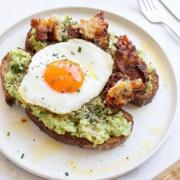Great British Bake Off Tonight's Bread Challenge

Making artisan breads takes time, practice and patience but once you’ve mastered the art, you’ll be wondering why you ever ate anything except homemade bread says LIFE Food Editor, SUSAN CLARK.
If you know someone who already makes sourdough bread, ask them for a small portion of their starter to get yours started. If not, mix equal parts of your preferred bread flour (white or wholemeal or rye) and water in a small tub which has a lid you can secure but also make holes in the allow the natural yeasts in the air to get to the dough mix and start the fermentation process for you.
Leave your new started on the kitchen counter for two days until it starts to bubble then keep in the fridge which helps to slow down the fermentation process.
Make your starter at least a week before you want to make your bread.
Please note this recipe uses 300g of starter and so it may take you a while to build enough starter if you are making yours for the first time from scratch. Remember, don't ever rush it! A good starter will need about five days of feeding (one tablespoon of flour to two tablespoons of tepid water every day or every other day)
Ingredients:
500g/1lb 2oz bread flour, plus extra for flouring
(One of the joys of making your own bread this way is that you can mix and match your flours and as you build your confidence you can become more and more adventurous!)
300g/10½oz sourdough
250ml/9fl oz water (lukewarm)
10g/¼oz brown sugar
10g/¼oz salt
flavourless oil, for greasing the bowl you are going to let your dough rise in.
A plastic dough scraper (don’t even attempt homemade bread without one of these)
And, for a truly professional finish, invest in a proving basket also known as a banetton.
Method:
Mix the flour, sourdough starter and water in a large bowl. Add the sugar and salt. Turn out on to a clean kitchen surface and knead for 10 minutes until you feel the dough coming together and forming a more solid shape. If you find your dough is very wet, don't panic. The trick is to take the dough to the flour on your worktop? Keep doing this... sticky side down as you knead and invest in a dough scraper... it makes all the difference!
Put the dough into a lightly oiled bowl, cover with a damp (warm water) tea-towel and let it prove for 2½-3 hours. You won't notice as much of a rise in the dough as you would with a normal yeasted bread so don't worry if the dough doesn't look all that much bigger when you check it.
Most recipes will now tell you to turn the dough onto a clean kitchen surface and knock back again but I think that's optional. I don't knock my breads back a second time and so simply scrape what will feel like quite a tacky dough into my proving basket (banetton and also worth investing in if you want a professional finish of the kind in this photo)
If you don't have a basket, line a pyrex bowl with a clean damp and floured tea towelto prevent it from sticking and use the shape of the bowl to help shape the dough to a dome shape during the second proofing stage. Use a mix of bread flour and semolina as this will help form a good crust when baking the final loaf.
Leave to prove for a further 2½ hours.
Preheat the oven to 230C/450F/Gas 8. Put a few ice cubes or cold water into a baking tin and place in the bottom of the oven to create steam.
Turn the loaves out onto a baking tray floured with a mix of flour and semolina (this will prevent sticking and help form the crust) or hot baking stone.
Using a thin sharp knife score two or three times on the top of the loaf and place in the oven.
Bake for 35-40 minutes or until a good crust has formed and the loaves sound hollow when tapped on the base.
Eat, share (if you can bear to) and enjoy!



























